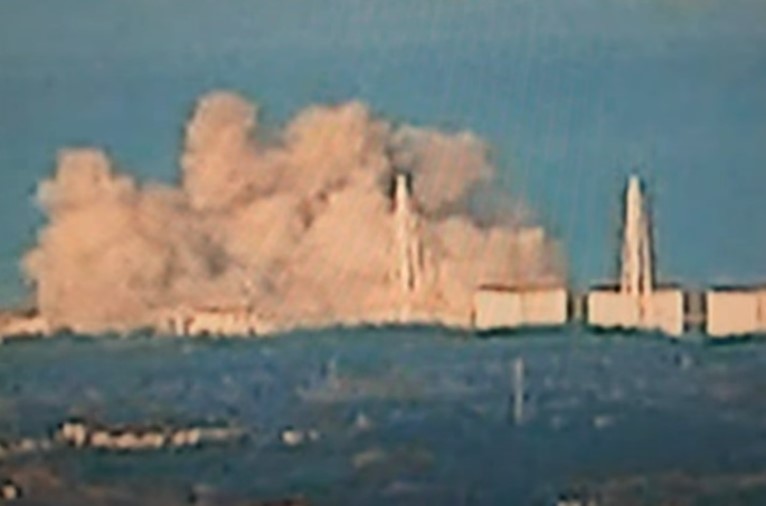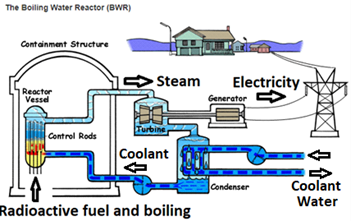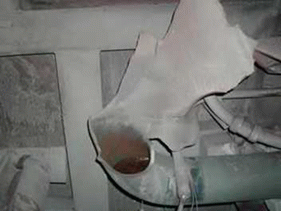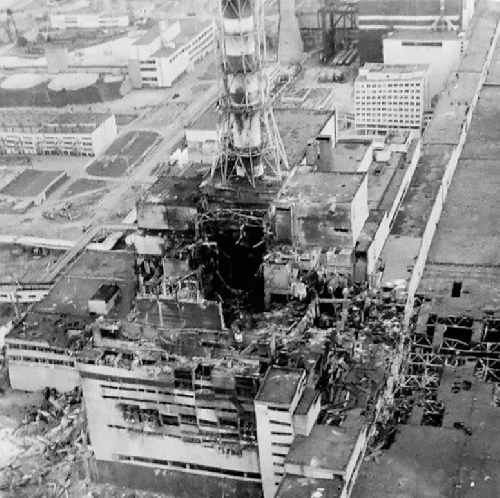The next nuclear power plant explosions like Fukushima or Three Mile Island will be here before 2039. Military attacks on Zaporizhzhia nuclear plants were near misses for a preventable radioactive disaster in Europe.
This article summarizes a series of Op Eds and peer-reviewed publications to present a basic understanding of a complicated, ever-present, danger to our lives. This article also continues a discussion of blockaded Freedom of the Press to confront these threats to our lives.
People fear the unknown enough to ignore that fear, and they let that fear into their homes. "The next nuclear power plant explosions bang at our doors" (click here). If we act now, those explosions can be stopped - period.
Nuclear Fear
"We should be afraid of nuclear power", but this fear can be quelled by knowledge (click here). I proved the causes of nuclear power plant explosions, and that same research proves how to fix nuclear plants to stop those explosions (Figure 1).
Steps have been recommended to stop the next nuclear power plant explosions. ("You can stop an explosive nuclear disaster: A message to nuclear power reactor operators", Click Here; "Stop a potential radioactive Europe and Russia - A letter to Energoatom, the Ukraine nuclear power company", Click Here; "Will we let a Ukraine nuclear power plant explode?", Click Here; "Nuclear threats - Part 4 - Take action against U.S. cover-ups in nuclear power and nuclear missile defense", click here).
I have now documented this cutting-edge research in 27 publications (See references at leishearengineeringllc.com). Op Eds simplify the complex technical proofs that are presented in conference and journal publications. This comprehensive research proves the talking points presented here.
Nuclear Power Plant Operations
Let's talk about how nuclear power plants work before talking about how they blow up. Nuclear fuels in nuclear reactors emit radioactive particles to boil water, and this boiling creates steam. Moving through pipes, steam blows into a turbine to spin an attached electrical generator.
Just like any electrical power plant powered by coal or oil, nuclear plants form steam to generate electrical power. This steam spins electrical generators to create electricity for us (Figure 2).
Smaller Nuclear Plant Explosions
Now, let's talk about smaller explosions in nuclear plants. During normal operations, nuclear fuel forms small amounts of explosive gases, where water breaks down into hydrogen and oxygen. This process is known as radiolysis, and this type of gas creation emits a blue light when water recombines.
There have been cases in nuclear reactor systems where radiolysis has accumulated enough flammable gas over time to explode steel pipes like firecrackers.
This process is known as water hammer. When pumps and valves are operated, the water in the pipes squeezes hydrogen and oxygen.
When the gases compress, they heat up, and explode. Similar to diesel fuel combustion in diesel engines, diesel fuel is preheated before it is compressed to ignite and burn. In a nuclear reactor system, combustion is not controlled like it is in diesel engines, and explosions detonate (Figure 3).
Disastrous Explosions
Turning our attention to nuclear disaster explosions, nuclear fuel demands continuous cooling water, or the nuclear fuel melts. This meltdown is the kindling for an explosive nuclear catastrophe.
If cooling water is lost to a nuclear reactor for any reason, a different process creates large amounts of hydrogen and oxygen. This thermolysis process occurs when excessive heat from melting fuel creates hydrogen and oxygen at fuel temperatures of more than 2800 Â degreesC.
Radiation to melt fuel is generated long after a nuclear reactor is shut down, and cooling is still required. Consequently, flammable gases for explosions can be created before and long after a nuclear reactor is shut down.
Bright white light emits during explosions from multiple chemical reactions (Figure 4). Different types of light are seen during plant explosions inside and outside of reactor systems ("Explosion differentiation using light emissions - Nuclear reactor, steam, water hammer, hydrogen, Piper Alpha, and hydro-volcanic explosions", in publication).

Figure 4: A small nuclear test reactor explosion shows a small white light explosion and a blue light shine during radiolysis.
(Image by US government) Details DMCA
Fukushima Explosions
Let's continue this talk by considering Fukushima. A tsunami wave followed an earthquake at sea. Approaching Japan from the ocean, a monumental wave grew as it reached the coast. This wave dwarfed the treetops, and the wave knocked out all electrical power and backup power to run the pumps needed to cool three operating reactors.
Bear in mind that the theory presented here was unknown to nuclear reactor operators, and operators were essentially operating blind during this disaster. They had been taught that a meltdown was impossible.
All three reactors melted down, and hydrogen plus oxygen formed from thermolysis. Later, water was added to the three reactors, and multiple explosions detonated. Radioactive dust circled much of the northern hemisphere of the earth from these explosions (Figure 5).
Several explosions detonated at each of the three reactor plants, and fires followed. If coolant water had been slowly added to molten reactors, and hydrogen gases had been vented, these hydrogen explosions could have been stopped.
Worldwide Explosions
Still talking with you, numerous explosions pepper the history of nuclear power ("Deceit is the core of nuclear power explosion safety ", click here).
More importantly, Three Mile Island (TMI) explosions detonated the same way as Fukushima explosions. However, radioactive materials stayed inside the TMI buildings ("Blasting into our lives - The Three Mile Island explosion cover- up: TV, myth, and reality", Click Here).Chernobyl explosions differed from TMI and Fukushima. Managers went to prison for criminal neglect that caused those explosions, which killed many people (Figure 6).
Fully understanding nuclear power plant explosions for the first time - ever - I researched the history of nuclear power plant explosions. A pattern was apparent for nuclear plant explosions. We were always told that a nuclear plant explosion could not happen, and unexpected new events blew up different plants.
Predicting Explosions - Zaporizhzhia
Assuming that the next plant explosions will be a random loss of coolant event, mathematics (statistics) was used to predict the next power plant explosions. Accordingly, the next plant nuclear reactor will meltdown and explode before 2039, and there is a 50 percent chance of a Fukushima type radioactive blast into our atmosphere.
When I performed this complicated math, I did not know what the next possible nuclear reactor explosions might be. Along came Zaporizhzhia.
As the Russia - Ukraine war progressed, Ukraine, Zaporizhzhia plants suffered near-miss military attacks. If missiles knocked out the coolant water, a meltdown and explosion could spread radioactive contamination across Europe, with mass evacuations and deaths ("The Ukraine nuclear scare - The IAEA endangered Europe and Russia", Click Here; A nuclear disaster in Europe can be stopped!", click here).
In other words, my prediction of an impending nuclear disaster was nearly proven. My prediction is still appropriate, even though we missed this particular nuclear power plant explosion. Although I do not know where the next preventable nuclear disaster will strike, the 2039 prediction still works.
A Fight for Freedom of the Press Goes On
As noted in this series of Op Ed News articles, 22 different news outlets and the American Nuclear Society blocked publication of public safety threats with respect to nuclear weapons defense ("Nuclear Threats - Part 2 - A fight for Freedom of the Press to say that we are not safe if nuclear bombs are fired at us", click here). Considering both missile defense and nuclear plant safety, this number of refusals increased to 23 when "The Conversation" declined publication of this article.
As part of a Press-wide blockade of new information, "The Conversation's" choice is another of more than 23 Press choices to block public safety threats and blockade Freedom of the Press.
A Conversation With One Editor
"The Conversation" claims to be 'dedicated to unlocking the knowledge of experts for the public good'. The choice to publish is theirs of course. More importantly, this article certainly fits this description, and lives are at stake.
A "Conversation" editor stated that 'I'm skeptical that anyone could make a case for such a sweeping assertion within our target length of 1,000 words and in language that general-interest readers who are not scientists or engineers could understand'. As a reader of this article, does this statement ring true?
That is, a draft of this article was submitted to "The Conversation" at their target length of 1,000 words, and they still refused. Similar to the other 22 news sources, they 'just do not like what they see in this article, even though loss of life is the concern'.
'Freedom From the Press'
The following statement was sent to the "The Conversation" upon publication of this article, and a response was not received.
'We disagreed, and I published elsewhere (Click Here). Even so, I believe that your decision is symptomatic of a larger problem of censorship of unpopular ideas by the Press, regardless of the importance to public safety.
Your organization has been identified as one of 23 Press organizations that blocked Freedom of the Press, through refusals to publish public safety threats. This action endangers lives from an imminent nuclear power plant explosion. Specific statements can be found in an article, titled "Nuclear Threats - Part 5 - An Incoming Nuclear Plant Explosion Disaster- Zaporizhzhia Near Missed This Next Disaster". Comments will be addressed in this article if received with three business days'.
Similar letters were previously sent to 26 news organizations with respect to nuclear power plant explosions. Fox News, Reuters, and Foreign Policy are not listed elsewhere in this series of articles. Earlier letters were also sent to the other 22 noted Press organizations with respect to potential loss of life in the event of nuclear war. No responses have been received from any of these organizations.
Publications of this public safety information were previously turned down by numerous magazines, including Smithsonian, National Geographic, Discover, and Science. These magazines were not informed of this article - seemed pointless.
Lives are in the hands of the Press, the government, and the nuclear industry. Jointly their actions constitute a cover-up of explosion dangers to our lives. That is, threats to life are clearly defined, yet those risks to life are withheld from the public.
Explosion Cover-up Liabilities
Those who orchestrate cover-ups incur responsibilities and liabilities when lives, property, and the environment are risked. Those who orchestrate cover-ups incur responsibilities and liabilities when the means to eliminate these risks are intentionally concealed. Concealing such facts constitutes dishonesty, i.e. lies are being promoted.
Many emails have been sent to nuclear industry watchdogs with respect to both types of nuclear threats. As applicable, emails have been sent to the ANS, the IAEA, the Japanese NRA, the NEA, the U.S. NRC, the U.S. DOD, and the U.S. DOE after almost every OpEd News article that I wrote, including this series of articles. No responses to these emails have been received from any of these organizations. That is, their inaction promotes loss of life when the next nuclear power plant explosion arrives.
When disaster strikes, and death tolls climb, there will be a written record of negligence and malfeasance by government and nuclear industry officials. When disaster strikes, and death tolls climb, there will be a written record of this Press cover-up.
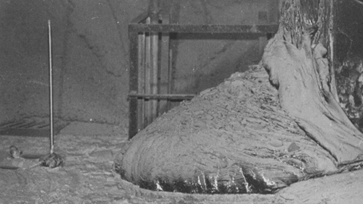
Figure 7: Radioactive fuel after the Chernobyl meltdown and explosion.
(Image by Russian government) Details DMCA
A Break in the Obstruction to Freedom of the Press
A pattern to block Freedom of Speech and Freedom of the Press keeps on banging against the facts ("Nuclear Threats - Part 6 - The Power of the Press to Crush Dissenting Opinions - The Reagan Years, the Past, and Today"). Again, OpEd News was the sole news publisher to allow new ideas to break through the Press blockade to Freedom of Speech to write and publish my thoroughly researched concerns to save lives.
Of importance to communicating this explosive public safety threat to the public, 1,448,800 people were reached during the initial broadcast (The George Elias Radio Show, Click Here, click here). In this show, an interview discussed explosion threats to the Zaporizhzhia nuclear power plants due to military attacks, and the interview discussed imminent explosion threats to world-wide nuclear power plants. OpEd News blazed the path for this radio show.
Stop the Next Explosions!
Potential nuclear reactor meltdowns would not have been prevented if a nuclear disaster happened due to a military attack at Zaporizhzhia, but explosions could have been stopped. In a loss of coolant accident, a room-sized radioactive blob would have been disastrous (Figure 7), but a radioactive dust cloud raining down over Europe and mass evacuations could have been stopped.
We need to overcome the fear of new ideas to change how people think, to change how we operate nuclear plants, and to stop the next explosions, which aim directly aim directly at us.
(Article changed on Dec 13, 2022 at 3:11 PM EST)


